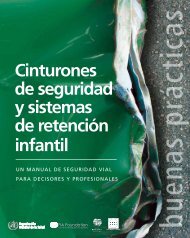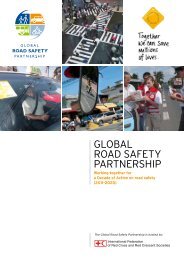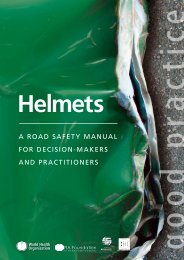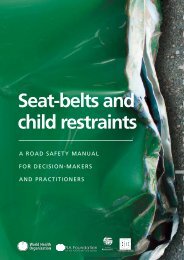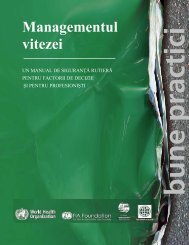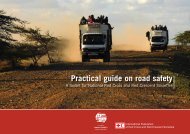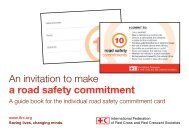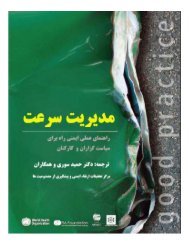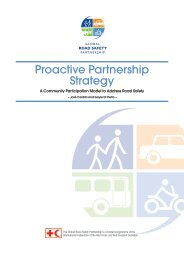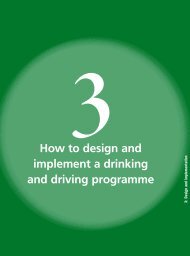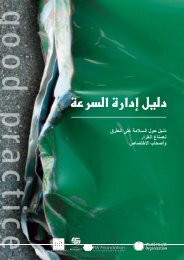How to evaluate the programme - World Health Organization
How to evaluate the programme - World Health Organization
How to evaluate the programme - World Health Organization
You also want an ePaper? Increase the reach of your titles
YUMPU automatically turns print PDFs into web optimized ePapers that Google loves.
Helmets: a road safety manual<br />
The results of <strong>the</strong> evaluation should be fed back in<strong>to</strong> <strong>the</strong> planning cycle and <strong>the</strong><br />
appropriate modifications <strong>to</strong> <strong>the</strong> <strong>programme</strong> made before it is fur<strong>the</strong>r expanded<br />
(Box 4.1).<br />
BOX 4.1: Increasing bicycle helmet use in schools in Malaysia<br />
4 | <strong>How</strong> <strong>to</strong> <strong>evaluate</strong> <strong>the</strong> <strong>programme</strong><br />
Bicycle fatalities constitute about 4%<br />
of all road traffic fatalities in Malaysia.<br />
The majority of <strong>the</strong>se deaths result from<br />
head injuries and tend <strong>to</strong> occur in rural<br />
areas. Until <strong>the</strong> 1990s, <strong>the</strong> use of bicycle<br />
helmets was rare in Malaysia. The first<br />
bicycle helmet <strong>programme</strong> was launched<br />
in 1995 by <strong>the</strong> Malaysian Helmet Initiative,<br />
a consortium of university, governmental<br />
and nongovernmental organizations that<br />
promotes <strong>the</strong> use of mo<strong>to</strong>rcycle and bicycle<br />
helmets. With support from corporate<br />
funders, <strong>the</strong> <strong>programme</strong> is a model of<br />
how different sec<strong>to</strong>rs can work <strong>to</strong>ge<strong>the</strong>r<br />
<strong>to</strong> prevent head injuries.<br />
The bicycle helmet <strong>programme</strong> was<br />
a multisec<strong>to</strong>ral initiative carried out by<br />
<strong>the</strong> country’s Road Safety Council at<br />
both state and district levels, and targeting<br />
rural children through local schools.<br />
Children who cycled <strong>to</strong> school were trained in <strong>the</strong><br />
proper use of helmets, which were provided free<br />
<strong>to</strong> those in <strong>the</strong> <strong>programme</strong>. With <strong>the</strong>ir parents also<br />
consenting, <strong>the</strong> children promised <strong>to</strong> use <strong>the</strong>ir helmets<br />
at all times when cycling. Their compliance in<br />
helmet use was assessed by <strong>the</strong> students <strong>the</strong>mselves,<br />
through questionnaires on <strong>the</strong> use of <strong>the</strong><br />
helmets, and through <strong>the</strong>ir reports on any crashes<br />
<strong>the</strong>y were involved in while cycling. Compliance was<br />
also confirmed by <strong>the</strong> school authorities and by <strong>the</strong><br />
<strong>programme</strong> organizers, who made unannounced<br />
monthly “spot checks” on children cycling <strong>to</strong> or<br />
from school.<br />
The results showed that compliance among <strong>the</strong><br />
students involved ranged from 31% <strong>to</strong> 98% across<br />
<strong>the</strong> various schools. The commitment of school<br />
authorities <strong>to</strong> <strong>the</strong> <strong>programme</strong> was considered a<br />
vital ingredient for sustaining <strong>the</strong> commitment of <strong>the</strong><br />
children involved. When asked why <strong>the</strong>y didn’t use<br />
helmets, children reported pressure not <strong>to</strong> do so<br />
Students are shown how <strong>to</strong> fit <strong>the</strong>ir bicycle helmets as part of this broad campaign<br />
<strong>to</strong> increase helmet use in Malaysian schools.<br />
from <strong>the</strong>ir peers, a lack of s<strong>to</strong>rage space at school<br />
for <strong>the</strong> helmets, and <strong>the</strong>ir unappealing colour.<br />
The lessons learnt from <strong>the</strong>se early <strong>programme</strong>s<br />
were incorporated in<strong>to</strong> subsequent ones. Children<br />
were charged a small fee for <strong>the</strong>ir helmets (ra<strong>the</strong>r<br />
than receiving <strong>the</strong>m free of charge), <strong>the</strong>re was an<br />
expanded choice of colour and design of <strong>the</strong> helmets,<br />
and suitable s<strong>to</strong>rage places for helmets were<br />
arranged in schools. Community partners have been<br />
brought in<strong>to</strong> <strong>the</strong> <strong>programme</strong>s and strenuous efforts<br />
made <strong>to</strong> ensure that <strong>the</strong> school authorities sustain<br />
<strong>the</strong>ir commitment <strong>to</strong> <strong>the</strong> initiative.<br />
Since <strong>the</strong> initial <strong>programme</strong> was launched in 1995,<br />
many of <strong>the</strong> schools involved have expanded <strong>the</strong>ir<br />
<strong>programme</strong>s, and at least one bicycle helmet <strong>programme</strong><br />
is now running in each state of Malaysia. In<br />
<strong>to</strong>tal, about 4000 students in 50 schools and about<br />
200 teachers have been involved in <strong>the</strong>se efforts<br />
aimed at reducing head injuries among children<br />
using bicycles.<br />
© Malaysian Helmet Initiative 2005<br />
137



